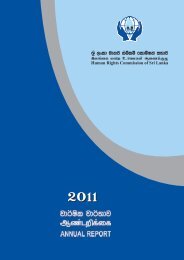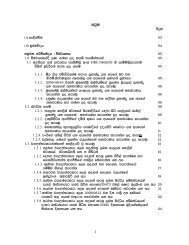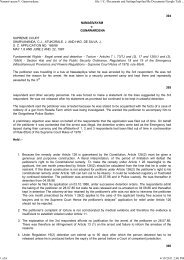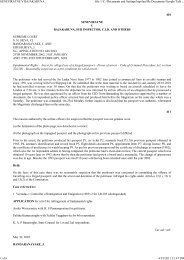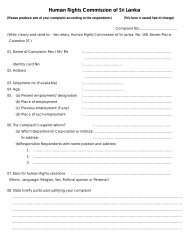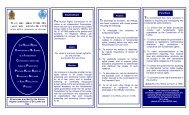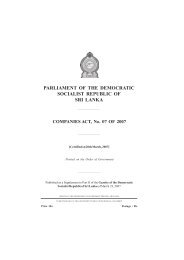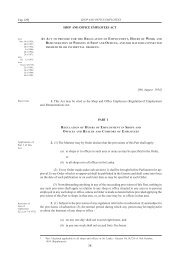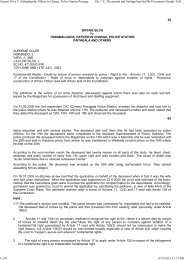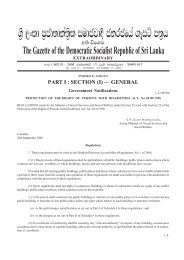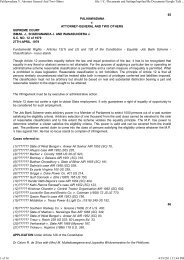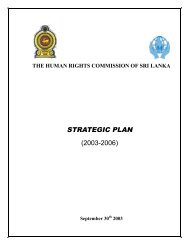Gamini Dissanayake (Petitio... - Human Rights Commission of Sri ...
Gamini Dissanayake (Petitio... - Human Rights Commission of Sri ...
Gamini Dissanayake (Petitio... - Human Rights Commission of Sri ...
Create successful ePaper yourself
Turn your PDF publications into a flip-book with our unique Google optimized e-Paper software.
<strong>Gamini</strong> <strong>Dissanayake</strong> (<strong>Petitio</strong>ner In Sc 4/91) V. Kaleel, M.C.M. And Others file:///C:/Documents and Settings/kapilan/My Documents/Google Talk ...<br />
There has been controversy as to the precise formulation <strong>of</strong> this rule against bias. Thus Lord Hewart's<br />
celebrated dictum in R. v. Sussex Justices (90), seems to suggest that those who decide must, like Caesar's wife,<br />
be above suspicion<br />
" Nothing is to be done which creates even a suspicion that there has been an improper interference with the course<br />
<strong>of</strong> justice."<br />
In Cooper v. Wilson, it was said<br />
" The risk that a respondent may influence the Court is so abhorrent .............. that the possibility <strong>of</strong> it or even the<br />
appearance <strong>of</strong> such a possibility is sufficient to deprive the decision <strong>of</strong> all judicial force, and to render it a nullity."<br />
The same notion appears in the headnote in Uannam v. Bradford City Council (91) . In Eckersley v. Mersey<br />
Docks and Harbour Board (92) , it was said that judges <strong>of</strong> all kinds must be free from even unreasonable suspicion <strong>of</strong><br />
bias. The better view however is that mere suspicion or possibility <strong>of</strong> bias is not enough. It is settled that actual bias<br />
need not be proved. Two tests vie for acceptance, was there a real likelihood <strong>of</strong> bias? (R. v. Essex Justices (93) , R.<br />
V. Cambome Justices (94) , R. v. Nailsworth Justices (95 ), R. v. Barnsley (etc) Justices (96) , Simon v. <strong>Commission</strong>er <strong>of</strong><br />
National Housing (97) ). Or would a reasonable person reasonably suspect that the tribunal might be biased ? (Law v.<br />
Chartered Institute <strong>of</strong> Patent Agents (98) , Metropolitan Properties v. Lannon ( 99)). Sometimes these two tests are<br />
interwoven as if they were one<br />
"...................if right minded persons would think that, in the circumstances, there was a real likelihood <strong>of</strong><br />
bias on his part, then he should not sit.......... Nevertheless there must appear to be a real likelihood <strong>of</strong> bias. Surmise<br />
or conjecture is not enough. There must be circumstances from which a reasonable man would think it likely or<br />
probable that [he] would, or did, favour one side unfairly at the expense <strong>of</strong> the other." (Lannon, at p 310)<br />
" If a reasonable person who has no knowledge <strong>of</strong> the matter beyond knowledge <strong>of</strong> the relationship which<br />
subsists between some members <strong>of</strong> the tribunal and one <strong>of</strong> the parties would think that there might well be bias, then<br />
there is in his opinion a real likelihood <strong>of</strong> bias " (Hannam at p 700)<br />
It has also been suggested that both tests produce virtually the same result (Hannam, at p 694). On the<br />
other hand it has also been pointed out that sometimes the two tests lead to different results (R. v. Barnsley Justices<br />
; and as in Dimes v. Grand Junction Canal).<br />
It seems to me that the test <strong>of</strong> bias has an objective as well as a subjective element. Apart from what a<br />
person legitimately interested in the matter may actually think, if there are circumstances which in the opinion <strong>of</strong> the<br />
court would lead a reasonable man to think it likely or probable that the adjudicator would or did favour one side<br />
unfairly, then the test is satisfied ; it does not matter (as in Dimes) that no one actually did think so ; and those<br />
circumstances need not have been known to the person concerned. The subjective element is that even if in those<br />
circumstances the court would not form that opinion, it may be that the objector knew only some <strong>of</strong> those<br />
circumstances ; if with such limited knowledge (as in R. v. Sussex Justices) he would reasonably think the<br />
adjudicator would or did favour the other side unfairly, then too the test is satisfied.<br />
The authorities cited fall into distinct categories. The first group relates to instances <strong>of</strong> actual or apparent<br />
participation in the deliberations <strong>of</strong> the deciding body, by complete " outsiders " (e.g. an " observer " in R. v.<br />
Leicestershire Fire Authority (100) , a witness in R. v. Bodmin Justices (101) or a party (e.g. Cooper v. Wilson ; R. v.<br />
Surrey Assessment Committee (102) or even its own <strong>of</strong>ficer (e.g. its clerk : R. v. Sussex Justices, R. v. Essex<br />
Justices).<br />
The next group <strong>of</strong> cases deals with the conduct <strong>of</strong> the adjudicators. The first point to be noted is that it is<br />
proper for a numerically large tribunal to authorise a small sub-committee drawn from its own membership to make<br />
preliminary investigations and recommendations, provided that the ultimate decision is by the main body. This is the<br />
effect <strong>of</strong> Queen v. L.C.C., ex p. Akkersdyk (103) , which held only that a member who had by his conduct made<br />
himself interested, could not sit with the main body. Similarly, in Jeffs v. N. Z. Dairy Products (etc) Board, the Privy<br />
Council did not consider it objectionable for the members <strong>of</strong> such a sub-committee to participate in the decision <strong>of</strong><br />
the main body ; that decision was held to be bad only because when the main body met, the members, other than<br />
the members <strong>of</strong> the sub-Committee, did not have all the evidence and submissions. It seems to me that all those<br />
35 <strong>of</strong> 56 4/20/2011 1:18 PM<br />
203<br />
204



